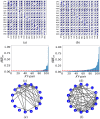Inference of financial networks using the normalised mutual information rate
- PMID: 29420644
- PMCID: PMC5805269
- DOI: 10.1371/journal.pone.0192160
Inference of financial networks using the normalised mutual information rate
Abstract
In this paper, we study data from financial markets, using the normalised Mutual Information Rate. We show how to use it to infer the underlying network structure of interrelations in the foreign currency exchange rates and stock indices of 15 currency areas. We first present the mathematical method and discuss its computational aspects, and apply it to artificial data from chaotic dynamics and to correlated normal-variates data. We then apply the method to infer the structure of the financial system from the time-series of currency exchange rates and stock indices. In particular, we study and reveal the interrelations among the various foreign currency exchange rates and stock indices in two separate networks, of which we also study their structural properties. Our results show that both inferred networks are small-world networks, sharing similar properties and having differences in terms of assortativity. Importantly, our work shows that global economies tend to connect with other economies world-wide, rather than creating small groups of local economies. Finally, the consistent interrelations depicted among the 15 currency areas are further supported by a discussion from the viewpoint of economics.
Conflict of interest statement
Figures






References
-
- Mauboussin MJ. Revisiting market efficiency: The stock market as a complex adaptive system. Journal of Applied Corporate Finance. 2002;14(4):47–55. doi: 10.1111/j.1745-6622.2002.tb00448.x - DOI
-
- Mantegna RN. Hierarchical structure in financial markets. The European Physical Journal B-Condensed Matter and Complex Systems. 1999;11(1):193–197. doi: 10.1007/s100510050929 - DOI
-
- Tumminello M, Aste T, Di Matteo T, Mantegna RN. A tool for filtering information in complex systems. Proceedings of the National Academy of Sciences of the United States of America. 2005;102(30):10421–10426. doi: 10.1073/pnas.0500298102 - DOI - PMC - PubMed
-
- Vodenska I, Becker AP, Zhou D, Kenett DY, Stanley HE, Havlin S. Community analysis of global financial markets. Risks. 2016;4(2):13 doi: 10.3390/risks4020013 - DOI
-
- Tumminello M, Coronnello C, Lillo F, Micciche S, Mantegna RN. Spanning trees and bootstrap reliability estimation in correlation-based networks. International Journal of Bifurcation and Chaos. 2007;17(7):2319–2329. doi: 10.1142/S0218127407018415 - DOI
MeSH terms
LinkOut - more resources
Full Text Sources
Other Literature Sources

